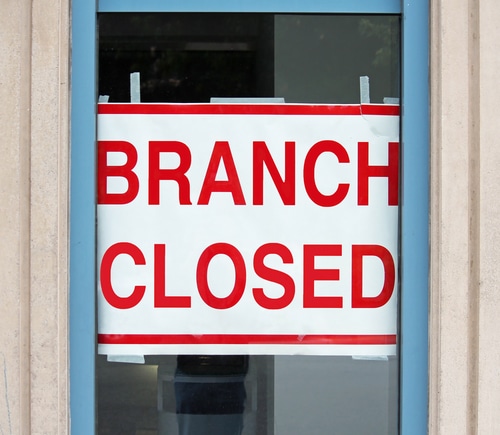From plant-based eating to working from home, the pandemic has accelerated dozens of lifestyle trends that existed prior to COVID-19. In the financial world, the macro trend is clear: it’s marching relentlessly toward digitalization—and firmly away from analog traditions.
With business fintech catching up to the personal fintech revolution, an increasing number of banks have been moving their lending operations online, simultaneously reducing their physical footprints. According to a Quartz analysis of data from the Federal Deposit Insurance Corp. (FDIC), the number of full-service bank branches fell from nearly 95,000 to just over 83,000 between 2010 and 2019—resulting in a loss of 12% of bank branches across the U.S.—with 23 counties losing more than 50 branches each in the process.
But that was 2019. With the onset of COVID-19 in 2020, this decade-long direction has accelerated exponentially. Today, physical branches aren’t simply closing. They’re closing at a rapid pace—and in higher volumes than ever before. Several community banks, including CB Financial Services in Carmichaels, PA, Mercantile Bank in Grand Rapids, MI, and Nicolet Bankshares in Green Bay, WI, recently reported plans to shutter a total of 12 branches—all of them permanently.
This acceleration is fine—and in fact welcome—for large businesses that were already leveraging digital lending channels before branches closed their doors.
But where does it leave small business customers whose only option for taking out a loan is to visit a branch? How can you account for their (and your) financial viability amidst a declining economy? Here are 3 future-proof steps for the new landscape of branchless small business lending.
Maximize accessibility
Even before branches were closing at their current velocity, many small business customers were unable to get inside. Already pressed for time and wearing multiple hats, small business customers seeking capital didn’t have the bandwidth to travel to a branch. This is exponentially true today.
Digital loan origination channels can keep your lending institution open 24/7, originating small business applications regardless of whether your branch is closed for the night or closed for good. By employing screening technologies and enabling a host of digital document uploading capabilities, digital loan origination channels allow you to originate more loans in less time—and at a fraction of the cost to you and your small business customers.
Digitize communications
Both your community bank and your small business customers value “relationship banking.” But the definition of that relationship is changing. Small business customers want (and need) convenience and flexibility. That’s why so many transactions end when they reach a website page that reads: “Visit a branch.”
Now, face-to-face interaction in the era of COVID-19 is even less appealing to small business owners than it was pre-pandemic. Without a branch to visit, redirections to physical branches are even more of a no-go zone.
By digitizing communications from the start, you can bring in more small business borrowers that don’t want to travel and speak to someone face-to-face, while saving your lending officers the time sink. But it’s not an all-or-nothing commitment. With a tailored solution, you can digitize as much or as little communication as you like—automating application intake but still meeting with your customer in-person to finalize the loan contract, if that’s what you choose.
Automate in-person processes
From faxing applicant documentation to filing financial records, paper-based manual processes were already tedious, time-consuming, and costly. Now, they’re failing. Without widespread access to physical branch offices, digital lending processes are becoming the new default—and they’re finally setting up your institution to serve small business customers.
How? By lowering the bar for small business lending. By automating manual, in-person processes like application intake, document management, and underwriting, you won’t just save your own institution working capital—you’ll reduce the cost barriers to small business lending. And you don’t have to do it all (at once or ever). Automating one thing doesn’t mean you have to automate everything. Set to your preferences, automation at any step(s) makes it more profitable for your institution to process small business applications and extend capital that—even if still a relatively small sum—can more than justify the means.
For more insights on how you can meet the changing capital needs of small businesses, download the eBook.



